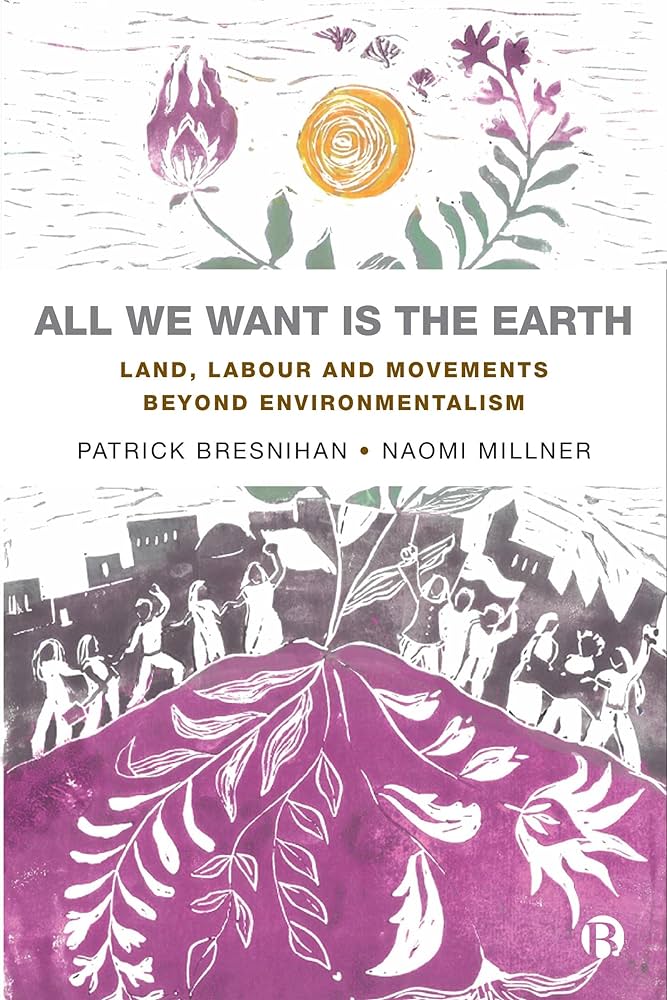In the age of social media, the term “vibe” is often used as shorthand for aesthetic, often with the substance shifted into the background and just picking up on the visual, sensory or language aspect of an object, movement, culture, or politics.

I was reminded of this term when reading the excellent new book from Patrick Bresnihan and Naomi Millner, All We Want Is the Earth: Land, Labour and Movements Beyond Environmentalism (2023). This is a serious study of the vibes of modern mainstream environmentalism (that part of the book feeds the pessimism of the intellect) and how the different alternative movements with strong environment bonds resonate in their ideas, challenges, and methods (feeding the optimism of the reader’s will in the process).
Admittedly it was the concept of resonance that got me thinking of vibes. Millner and Bresnihan fit their analysis between two extremes: on the one hand, conflating different struggles and contexts in a reductionist way, and on the other hand surrendering to the complexity of relations in the world system, denying any ability to analyse and relate.
To resonate, explain the authors, there needs to be a difference and a distance (just like a good rhyme). This is the lens with which the authors take us from Amílcar Cabral and Ken Saro-Wiwa to Shell to Sea in Co. Mayo and Zapatistas. The expertise of the authors, both experienced geography academics, brings us in close contact with otherwise ignored times and spaces in mainstream environmentalism; the accounts of Central and South American practices and struggles are particularly illuminating and detailed.
Mainstream environmentalism in the second half of the twentieth century saw a transition into environmental management, the authors claim, with a well-structured set of evidence presented through a compelling narrative of often unquestioned idealisations of environmental struggles of the old. This consolidated the imaginaries of environmentalism, what the environment should be like, what wilderness is, and what environmentalist struggle should look like.
And then there is the environmental struggle in the Global South, born out of necessity, which is often not dubbed environmentalist, as it picks up on all the interconnected challenges of colonialism, capitalism, and imperialism.
The authors also deliver an important critique of the one-worldism in the mainstream media and messaging from large international organisations: Anthropocene on the surface accepts the human responsibility for the climate emergency but at the same time dilutes and equates everyone’s contribution, refusing to recognise the class issues and capital burning the world
On the day I wrote this review the Guardian published a climate change story headed “‘Off-the-charts records’: Has humanity finally broken the climate?” This is just one illustrative example of how the “unity” of humanity aims to absolve the guilty and demoralise others.
Political aesthetics of environmentalism is the tagline we could put on this book. The authors actively explore what gets to be called and painted as environmentalism and environment, what is mainstream and what is left in the Arguably, where Bresnihan and Millner choose to frame their argument in terms of Jacques Rancière’s notion of disagreement; similar arguments could be made in terms of Marxist contradictions.
This is left as an exercise to the reader: the authors are not going into political analysis of the movements. They clearly spell out, however, the issues of capitalist exploitation, and how these issues cut deep into environment, public health, and the relationship communities have with the places and spaces.
The authors correctly recognise the co-opted “First World” environmentalist language picked up by corporations and states in the commodification and disaster-capitalist visions of climate change, opposing it to community organising in the “Third World,” coinciding with anti-colonial and anti-capitalist movements rising after the Second World War.
There is a gap that might need filling in another book: the “Second World.” There are no references to environmental movements in the socialist states, or how the planned economy and post-revolution reconstruction of socialist states dealt with environmental issues. A modern example that comes to mind is that of Cuba’s “Tarea Vida,” well presented in Helen Yaffe’s documentary Cuba’s Life Task: Combating Climate Change.
The artistic thread throughout the book is a vital component of it, both in describing various artistic interventions and providing illustrations (and refreshingly uplifting prose).
■ All We Want Is the Earth: Land, Labour and Movements Beyond Environmentalism by Patrick Bresnihan and Naomi Millner will have its Dublin launch on Tuesday 26 September at 7 p.m. in Connolly Books, East Essex Street.






